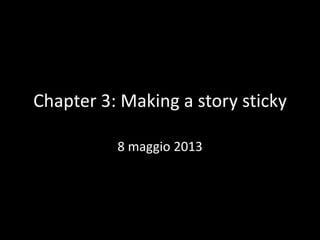Presentation 4
•Descargar como PPTX, PDF•
1 recomendación•398 vistas
Denunciar
Compartir
Denunciar
Compartir

Recomendados
Recomendados
Más contenido relacionado
La actualidad más candente
La actualidad más candente (20)
Writing for Publication: A Joint VdGM/EGPRN/EJGP Workshop (2013)

Writing for Publication: A Joint VdGM/EGPRN/EJGP Workshop (2013)
ENGL 309 Project 4 Assignment Sheet: Imitative Essay

ENGL 309 Project 4 Assignment Sheet: Imitative Essay
Similar a Presentation 4
Similar a Presentation 4 (20)
Writing for publication 2017 argument and mindmapping the article

Writing for publication 2017 argument and mindmapping the article
Último
Mehran University Newsletter is a Quarterly Publication from Public Relations OfficeMehran University Newsletter Vol-X, Issue-I, 2024

Mehran University Newsletter Vol-X, Issue-I, 2024Mehran University of Engineering & Technology, Jamshoro
https://app.box.com/s/x7vf0j7xaxl2hlczxm3ny497y4yto33i80 ĐỀ THI THỬ TUYỂN SINH TIẾNG ANH VÀO 10 SỞ GD – ĐT THÀNH PHỐ HỒ CHÍ MINH NĂ...

80 ĐỀ THI THỬ TUYỂN SINH TIẾNG ANH VÀO 10 SỞ GD – ĐT THÀNH PHỐ HỒ CHÍ MINH NĂ...Nguyen Thanh Tu Collection
Último (20)
UGC NET Paper 1 Mathematical Reasoning & Aptitude.pdf

UGC NET Paper 1 Mathematical Reasoning & Aptitude.pdf
Sensory_Experience_and_Emotional_Resonance_in_Gabriel_Okaras_The_Piano_and_Th...

Sensory_Experience_and_Emotional_Resonance_in_Gabriel_Okaras_The_Piano_and_Th...
Kodo Millet PPT made by Ghanshyam bairwa college of Agriculture kumher bhara...

Kodo Millet PPT made by Ghanshyam bairwa college of Agriculture kumher bhara...
This PowerPoint helps students to consider the concept of infinity.

This PowerPoint helps students to consider the concept of infinity.
Unit 3 Emotional Intelligence and Spiritual Intelligence.pdf

Unit 3 Emotional Intelligence and Spiritual Intelligence.pdf
Beyond_Borders_Understanding_Anime_and_Manga_Fandom_A_Comprehensive_Audience_...

Beyond_Borders_Understanding_Anime_and_Manga_Fandom_A_Comprehensive_Audience_...
General Principles of Intellectual Property: Concepts of Intellectual Proper...

General Principles of Intellectual Property: Concepts of Intellectual Proper...
Food safety_Challenges food safety laboratories_.pdf

Food safety_Challenges food safety laboratories_.pdf
80 ĐỀ THI THỬ TUYỂN SINH TIẾNG ANH VÀO 10 SỞ GD – ĐT THÀNH PHỐ HỒ CHÍ MINH NĂ...

80 ĐỀ THI THỬ TUYỂN SINH TIẾNG ANH VÀO 10 SỞ GD – ĐT THÀNH PHỐ HỒ CHÍ MINH NĂ...
Python Notes for mca i year students osmania university.docx

Python Notes for mca i year students osmania university.docx
Presentation 4
- 1. Chapter 3: Making a story sticky 8 maggio 2013
- 2. From Writing Science: How to Write Papers That Get Cited and Proposals That Get Funded, Joshua Schimel, 2011
- 3. SUCCES: Making a story sticky • • • • • • S: Simple U: Unexpected C: Concrete C: Credible E: Emotional S: stories
- 4. Simple • Find the simple message that captures the essence of your research paper • Simple ≠ Simplistic • Simplistic messages dumb down or trivialize the issue or dodge the core of the problem
- 5. Simple • Example of a simple idea: Natural selection • “Fit organisms survive and pass on their genes while unfit ones don’t”
- 6. Simple: schemas • Schemas are how we structure information • Example schemas: – How electricity is transmitted – How a motor works • When we learn, we add to our schemas • When you write, aim for your potential readers’ schemas
- 7. Unexpected • Frame the knowledge gap by using what is known to identify the boundaries of that knowledge
- 8. Unexpected • Find what is novel in your results and highlight the unexpected elements • Frame new questions and look for new insights • What is the knowledge gap you are answering in your paper?
- 9. Concrete • Science has both a concrete side: the data • And an abstract side: the ideas • Abstract and concrete are a continuum, not a dichotomy: from the concrete data to abstractions of these data to abstractions of these abstractions, and so forth • Most research is at a middle level of this continuum
- 10. Concrete • To make your paper more readable: – Ground and define your specific concepts in widely understood schemas or in the details that explain the abstractions
- 11. Credible • Credibility goes hand in hand with concrete • Our IDEAS are credible when we ground them in previous work and cite those sources • Our DATA are credible when we describe our methods, present the data clearly and use appropriate statistics • Our CONCLUSIONS are credible when we show that they grow from those data
- 12. Emotional • The fundamental emotion in science is CURIOSITY • You need an engaging question, not just data • You engage curiosity by shifting your focus from “What information do I have to offer” to “What knowledge do I have to offer” • Emotion is particularly important for proposals
- 13. Stories • Stories are modular: a single large story is crafted from several smaller story units threaded together • When writing, think about internal structure and how to integrate these story modules • As you discuss your data and ideas, find units that you can package into coherent modules
- 14. Summary • Before you start writing, figure out how you are going to weave these six elements into your work • Figure out the simple story • Build it around the key questions that engage UNEXPECTED and EMOTIONAL • This will guide you in selecting the material you need to make the story CONCRETE and CREDIBLE
- 15. Exercises • Analyze a research paper: how did they use each SUCCES element? – Did they do a good job? – Could they have improved? If so, how? • What schemas did the authors use in building their story – Are these schemas only held by a narrow subdiscipline or by a wider community?
- 16. Exercises • Analyze the article you wrote for chapter 2 – How well did you use the SUCCES elements? – How could you improve it, if not? – Rewrite key passages to enhance their SUCCES power